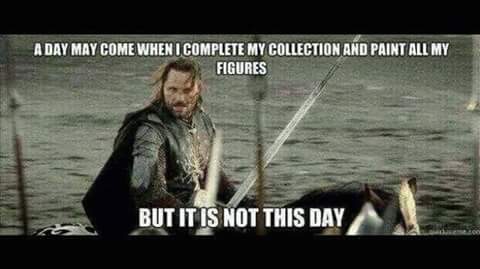March, 1945. Somewhere in Germany. General idea is that a key village of ruins was abandoned by cowards and now it is a race to occupy first, either invader or defender of the Reich.
This was intended to be a local playtest of
Blitzkrieg Commander II. While the group is solidly in the Flames of War camp, I owned the rules for a few years now and recently played a
game in another town and wanted to give it a go locally. Each side of three players had a touch over 5000 points to play with, though in FoW terms it would just be a tad over 2000. Click to big-up the pictures.
 |
| Playing the long way, a view from the German end of the table. |
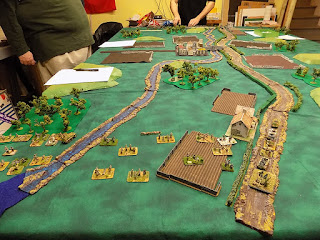 |
| Initial German moves. The Americans have already moved. |
 |
Using a Warmaster activation system sub-commands can move,
fire, deploy, etc. up to (house rule) three activations. |
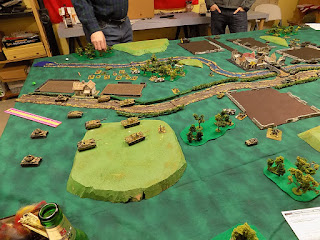 |
| Seven German tank destroyers against 13 Sherman variants. |
 |
Artillery has a deviation roll and one of the early American barrages
deviated into a mass of Germans with deadly results. |
Each "army" or battlegroup has a break point. After the above barrage the Germans were halfway to theirs and the Americans hadn't taken any losses yet.
 |
| Shermans and self-propelled artillery advance into a meat-grinder. |
 |
US airpower, with total air superiority, kept chipping away at the
Germans but could never land two missions in the same turn. |
 |
As vehicles were knocked out we removed them. Next time we'll
leave wrecks on the field. |
 |
The village ruins are paper buildings from David Graffam. Various
wrecks would normally be seen. |
 |
Unlike Flames of War, the Jagdpanthers long range guns really
mattered and they had Ostwinds to protect them. |
 |
US armored infantry couldn't decide whether to advance on foot
or on their halftracks. |
 |
One of our lads all grown up and home on leave from Korea.
Thanks Jake! |
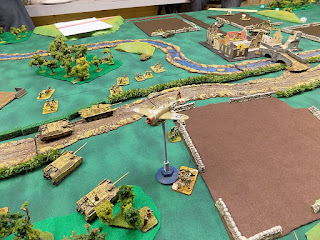 |
P-47s darted about the skies all day but never could do much
more than suppress their targets. |
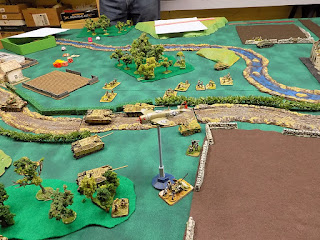 |
The tank destroyers kept knocking out Shermans, though the
Germans hit their break point. And passed the test. |
 |
The Germans passed three break tests and then the American
infantry wandered into range of the German 15cm guns. |
The picture shows all of the US infantry left after the dust settled. Infantry in the open are very vulnerable to artillery and it was made worse by incredible rolls to hit. NEVER complain about your dice again Bob, you've been on an incredible run for months! :-)
 |
| "Wo ist der Amerikaners?" |
The Americans failed their nearly impossible break test roll and the remainders, mostly command and observers, fled the field. Just for kicks we tested the Germans and they passed, granting them a decisive victory.
All game systems have their goofy abstractions. In the case of BKC you can never chip away at monster tanks over the course of the game. You either kill it in one turn or it regenerates like a Troll and all hits go away. The possibility of doing nothing in a turn annoys me. Without entering a discussion about "friction" and "fog of war" it comes down for me to the desire to play with my toys. I don't want to sit on my hands. To combat this we give each sub-command a reroll on their first failed command check.
Reaction seemed generally good from the group, though I'm happy just to amortize the cost of my investment a bit more. I expect we will try it again in the future.
